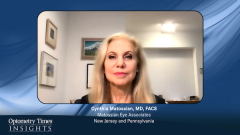
Seeking Out Medical Care for Dry Eye Flares
Dr Matossian explains the importance of treating dry eye flares and what can happen if they are left unchecked.
Cynthia Matossian, MD, FACS: What percentage of patients who are having a flare seek our help? It‘s hard to determine that number because we‘re just focusing on flares, but about 80% of patients have some episodic, intermittent exacerbation of their eye symptoms. About half of those patients actually have no chronic eye symptoms on a continuous basis. Some of these patients are known to have dry eye disease, and some of them are absolutely new to this whole topic. They come in not knowing they have dry eye disease. They don’t know the cause of their ocular symptoms until they get the diagnostics and the definitive disease diagnosis.
What percentage of patients with dry eye flares are diagnosed with dry eye disease? This area is growing, and we don‘t have concrete numbers. These numbers are changing as our understanding of these nuances within dry eye disease are becoming more robust.
We know that about 50% of patients who are experiencing dry eye flares have no continuous symptoms. Whereas a much higher percentage of patients with known dry eye disease can become more cognizant and aware if there‘s a change or an uptick or a worsening of their dry eye condition. But with that said, even though we have tens of millions of people who have dry eye disease in the United States, and actually, globally, a very small percentage of patients are diagnosed. And an even smaller percentage of patients are treated with something more than over-the-counter artificial tears.
Inflammation is the cause of dry eye disease. Dry eye flares let the patient know there is progression, there is worsening, there is dysregulation of the tear film, and the homeostasis is broken. If we, as eye care providers, don‘t diagnose and intervene, the inflammatory cycle is going to continue to spin out of control, adding more ocular surface stress to the tear film, and making more inflammatory biomarkers prevalent on the ocular surface, leading to ocular surface damage. We want to break that cycle. The best way to do that is by diagnosing patients early and treating proactively to minimize the number of flares and the permanent sequelae.
Transcript edited for clarity.
Newsletter
Want more insights like this? Subscribe to Optometry Times and get clinical pearls and practice tips delivered straight to your inbox.















































.png)


